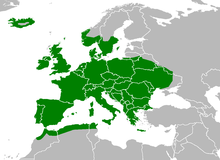Wood mouse
The wood mouse (Apodemus sylvaticus) is a common rodent. It is also known as the long-tailed field mouse, field mouse, common field mouse, and European wood mouse.
| Wood mouse | |
|---|---|

| |
| Scientific classification | |
| Domain: | Eukaryota |
| Kingdom: | Animalia |
| Phylum: | Chordata |
| Class: | Mammalia |
| Order: | Rodentia |
| Family: | Muridae |
| Genus: | Apodemus |
| Species: | A. sylvaticus
|
| Binomial name | |
| Apodemus sylvaticus | |

| |
| Apodemus sylvaticus range (in green) | |
| Synonyms | |
|
Mus sylvaticus Linnaeus, 1758 | |
Habitat
changeAlmost entirely nocturnal, field mice burrow extensively, digging a series of chambers and runs. Their usual habitat is woodlands, fields and hedgerows, although they are also found in open grassland.
History
changeThe geographical isolation and recent glacial history of Shetland means there are few mammals there. The field mouse, the brown rat, and the house mouse are one of only three types of rodent on the islands. They were thought to have come from Norway around the 9th century AD with the arrival of the Vikings. There is archaeological evidence that wood mice were present during the Middle Iron Age (around 200 BC - AD 400), and one theory is that Apodemus came from Orkney where a population had existed since at the least the Bronze Age.
Field mouse
changeField mouse is the name for a large group of mice in the UK but the real field mouse is the Long Tailed Field Mouse or wood mouse.
Appearance
changeThey have a solid brown coat with a white belly. For their size, they have very large eyes and ears. They grow to roughly 10 cm long and weigh 30 grams when full grown.
Eating habits
changeThey are omnivorous and eat seeds, worms, berries, small insects and carrion. In deciduous woodland they will eat acorns and sycamore seeds for the winter, buds in spring, insects and seeds in summer and berries and fungi in autumn. They will eat their own tail if faced with starvation.
Predators
changeThey are prey to many animals, including owls and foxes and therefore have a short life, normally living for 6 to 12 months. However, in captivity they can live for over 20 months. They live in any place where they can find food or shelter but traditionally live in hedgerows, forests and grass lands. They make their nests wherever it is warm and there is cover. This means that they will usually nest underground but will nest in other warm environments.
Psychology
changeThe Field mouse has been proven to be extremely intelligent. If given time, it will think out a strategy before doing something. They have extremely small but sharp claws, which they use to dig into houses to scavenge food. They assess a situation before doing anything. They will judge whether it is too risky, dangerous or useless and they often look out for each other. However, if they are being chased, they will dart undercover or into small nooks and crannies.
References
change1. ^ Goaman, K., Amery, H. (1983). Mysteries & Marvels of the Animal World: pg.15
2. ^ Schlitter & Van der Straeten (2004). Apodemus sylvaticus. 2006 IUCN Red List of Threatened Species. IUCN 2006. Retrieved on 11 May 2006. Database entry includes a brief justification of why this species is of least concern
3. ^ Nicholson, R.A., Barber, P., and Bond, J.M. (2005). New Evidence for the Date of Introduction of the House Mouse, Mus musculus domesticus Schwartz & Schwartz, and the Field Mouse, Apodemus sylvaticus (L.) to Shetland. Environmental Archaeology 10 (2): 143-151
